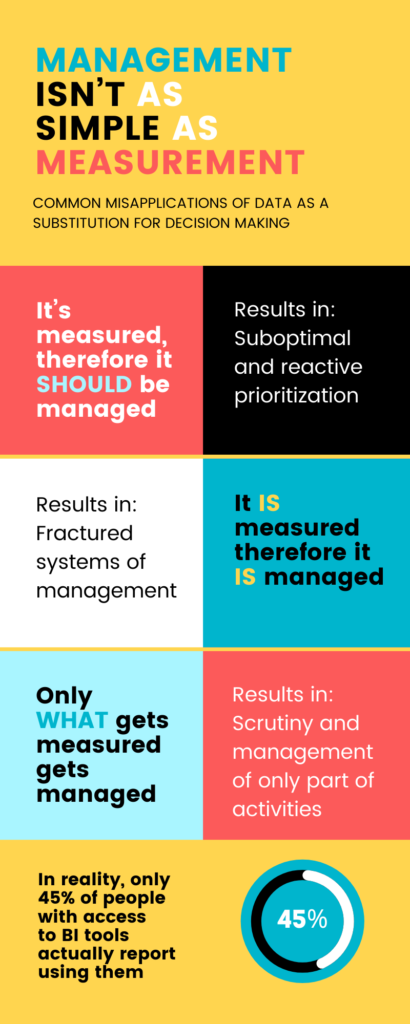There is an old adage in business: “What gets measured gets managed.” This saying is often attributed to Peter Drucker, but its origins may go back to Lord Kelvin and the 1800s. In any case, on the face of it, the premise is simple. By understanding the data and numbers generated by your work, you are in a much better position to manage and adapt the work. So, data is key to a successful organization.
But, is it really as simple as that?
What is so difficult about acting on something visual, measurable, and data-driven? The subsequent actions, or lack of, of an individual, come down to a gap in interpretation. Graphing collected data and giving it to people regularly isn’t enough to change the world.
In my experience as a data consultant and product manager, the way organizations utilize data to inform and mobilize their operations differs wildly across businesses – producing accordingly different results. Having used data to make business decisions, manage people, and build new products, I’d like to highlight common misconceptions about what it means to ‘measure to manage’ and ways to improve these practices.
Management practices determine the trajectory of an organization’s success. Choosing what information to disregard is to focus – and what is focused on is what is acted upon.
Misinterpretation of the use of data comes in many forms, here we examine a few.
1. It is measured, therefore it SHOULD be managed
Some organizations will measure everything to the finest detail and manage the business to hit the numbers. This exclusive focus on the data causes a multitude of issues – suboptimal and reactive prioritization as one set of KPIs is down one day and another set down the next, destructive targeting, and a disconnect between the numbers and the reality of the situation. For instance, when doctors are under pressure to meet targets, the actual quality of care reduces because the doctors focus on clearing their backlog with easily treatable cases and deferring the more complex, time-consuming patients.
2. It IS measured therefore it IS managed
Some organizations conclude that the simple act of measuring (and sharing) results of business activities equates to these activities being “self-managed”. By creating huge libraries of complex and colourfully presented data for staff consumption, all responsibility of managing the work to move these particular needles is deferred to the recipients (and sometimes the creators of the data). Simply pointing at numbers without understanding the root cause can manifest itself as occasional “blame storms” where each individual is left to interpret the data with their own approach – creating a fractured system.
I have personally seen this scenario a number of times when a company forks out a large budget on a new Business Intelligence system, labouring under the belief that data will fix all their problems. All efforts and budget go into implementing the new system and creating (or often just re-creating) collateral in the shiny new system, without stopping to think about whether the right things are being measured. The phenomenon of style over substance is something that needs to be consciously avoided
3. Only WHAT gets measured gets managed.
A special case of #1 where organizations intensely focus on only a few KPIs – ignoring all others. The question is, how is the organization choosing what is being measured and therefore managed? Does the toolset define the story? Is the story limited to the abilities of the manager? In this case, outcomes from decisions seem unrelated or surprising and what is being measured is irrelevant or a lagging indicator of only a part of the series of decisions leading up to an outcome. Larger business initiatives and long-term objectives don’t hinge on week over week performance; they are holistic views. In aviation, we see this phenomenon where the operational data retrieved from modern aircraft is seen as an engineering and flight planning asset.
In reality, without good measurement, good management is significantly more difficult to achieve, but simply collecting, packaging, and sharing data is not enough. In a world where more and more data is available and methods to interpret, visualize, and model data are increasingly complex, far more than Drucker, Kelvin et al could possibly have imagined, the area that is most often overlooked is how data is communicated. Specifically, communicating data in a way that elicits the desired changes from the audience and understanding that each audience member has different roles, goals, and motivations. Perhaps it’s time to change the adage to reflect the modern data saturated world:
“Manage by measuring what’s important and measure the effects of what is managed”?

Published: 4th November 2021



